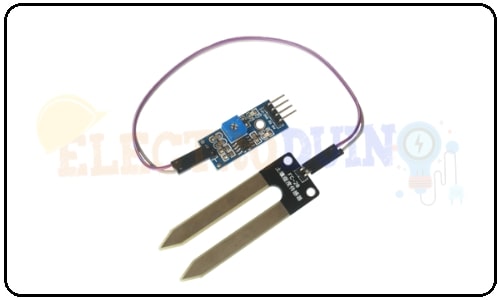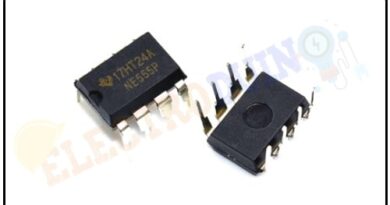Soil Moisture Sensor | How it’s Works
Hello friends! Welcome back to ElectroDuino. This blog is base on Introduction to Soil Moisture Sensor | How Soil Moisture Sensor Works. Here we will discuss the Introduction to Soil Moisture Sensor Module, sensor pin diagram, Working Principle, Features, and applications.
Introduction
A Soil Moisture Sensor is one kind of low-cost electronic sensor that is used to detect the moisture of the soil. This sensor can measure the volumetric content of water inside the soil. This sensor is consists of mainly two parts, one is Sensing Probs and another one is the Sensor Module. The probes allow the current to pass through the soil and then it gets the resistance value according to moisture value in soil. The Sensor Module reads data from the sensor probes and processes the data and converts it into a digital/analog output. So, the Soil Moisture Sensor can provide both types of output Digital output (DO) and Analog output(AO).
Soil Moisture Sensor Module Pin Diagram

| Pin Number | Pin Name | Description |
| 1 | VCC | +5 v power supply |
| 2 | GND | Ground (-) power supply |
| 3 | DO | Digital Output (0 or 1) |
| 4 | AO | Analog Output (range 0 to 1023) |
Soil Moisture Sensor Module Hardware Overview
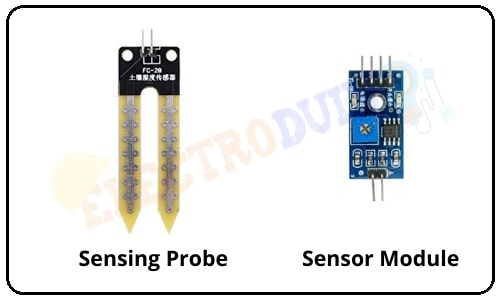

This Module is consists of mainly two parts, one is Sensing Probes and another one is the Sensor Module.
Sensing Probes
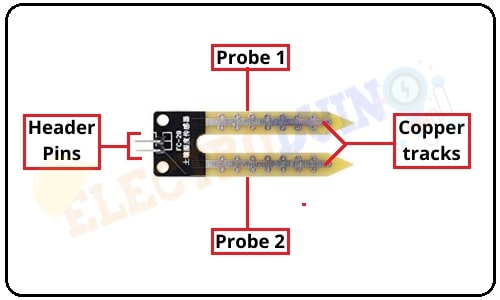

The Sensing Probes consists of two nickel-coated copper tracks. Also, it has two Header pins, these are internally connected to the two copper tracks of the Sensing Probes. These pins are used to connect the Sensing Probes to Sensor Module through two jumper wires. Always, one pin of the sensor module provides a +5v current to the one Probe, and another pin of the sensor module has received the return current from the other Probe.
Normally under dry soil conditions, it provides high resistance and less conductivity. So, the 5v current cannot be passed from one probe to another probe. Its resistance will vary according to the amount of water in the soil. When more water in the soil its resistance will decrease and conductivity will increase. So, when water increasing in the soil it can pass more current from one probe to another probe.
Sensor Module



The key components of the Sensor module circuit are LM393 Comparators, Variable Resistor (Trimpot), Power LED, output LED.
1. Variable Resistor (Trimpot)
This sensor circuit has a 10k Trimpot or variable resistor(potentiometer). It is used to set the sensitivity of the Soil Moisture Sensor by rotating the Trimpot knob. If rotated the preset knob in the clockwise direction, the soil moisture sensor module sensitivity will be increased. If it rotated in the counterclockwise direction, the module sensitivity will be decreased.
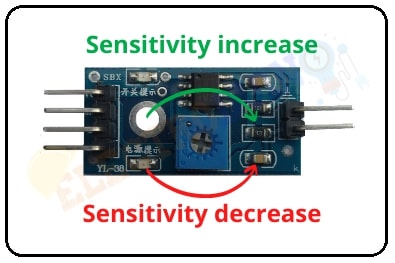

2. Power LED
This onboard LED indicates the sensor power supply is ON or OFF. When we will turn on the sensor power supply then this LED is also turn ON.
3. Output LED
When the sensor detects the moisture or water in the soil, the RED LED is turn on. When it does not detect any moisture or water in the soil, the RED LED is turn off.
How Soil Moisture Sensor Works
At first, we need to connect the Sensing Probe to the Sensor Module circuit using the jumper wire and enter the props into the dry soil. Now connect the sensor to the 5v power supply. Then set the threshold voltage at the Non-Inverting input (3) of the IC in dry soil condition by rotating the potentiometer knob for setting the sensor sensitivity.
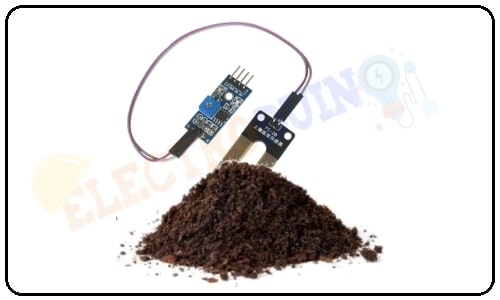

When more water in the soil then prob’s conductivity will increase and resistance will decrease. So, a Low amount of voltage from the sensing probe is given to the Inverting input (2) of the IC. Then the LM393 Comparator IC compares this voltage with the threshold voltage. In this condition, this input voltage is less than the threshold voltage, so the soil sensor output goes LOW (0).
When less water in the soil then prob’s have low conductivity and high resistance. So, a High amount of voltage from the sensing probe is given to the Inverting input (2) of the IC. Then the LM393 Comparator IC compares this voltage with the threshold voltage. In this condition, this input voltage is greater than the threshold voltage, so the sensor output goes High (1).
Soil Moisture Sensor Specifications
| Parameter | Value |
| Operating Voltage | 3.3V – 5V |
| Operating Current | 15 mA |
| Comparator chip | LM393 |
| Sensitivity | Adjustable via Trimpot |
| Output type | Analog output voltage (AO) and Digital switching voltage (DO) |
| LED lights indicators | Power (red/green) and Output (red/green) |
| Sensing Probes | Nickel plate on one side. |
| Module PCB Size | 3.2cm x 1.4cm |
Application
Soil Moisture detection
- It’s used in an irrigation system when soil is dry it starts the watering system automatically.

